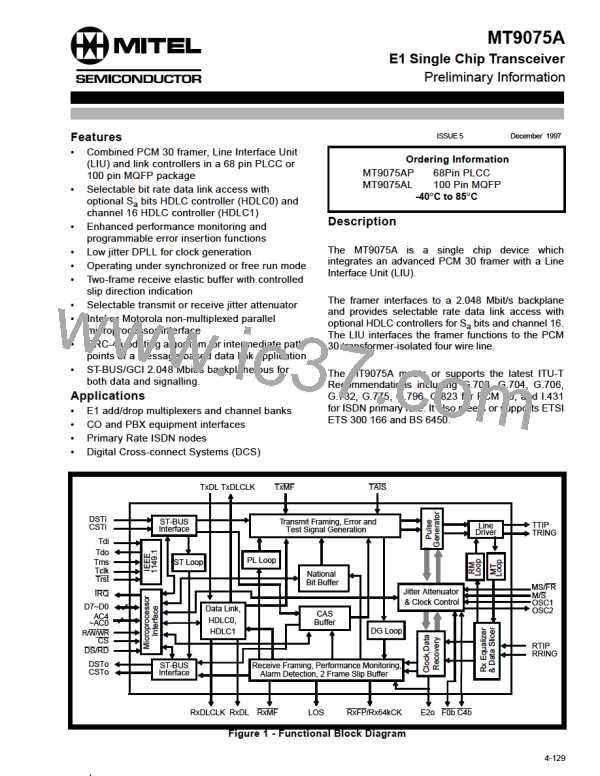MT9075A
Preliminary Information
•
A short frame exists if there are less than 25
HDLC Functional Description
bits between the flags. Short frames are
ignored by the receiver and nothing is written
to the receive FIFO.
Packets which are at least 25 bits in length
but less than 32 bits between the flags are
also invalid. In this case the data is written to
the FIFO but the last byte is tagged with a
“bad packet” indication.
If a frame abort sequence is detected the
packet is invalid. Some or all of the current
packet will reside in the receive FIFO,
assuming the packet length before the abort
sequence was at least 26 bits long.
The HDLC controller can be reset by either the reset
pin (RESET, pin 11 in PLCC or pin 84 in MQFP) or by
the control bit HRST at address 1BH in page 0BH
(for HDLC0) or page 0CH (for HDLC1). When reset,
the HDLC Control Registers are cleared, resulting in
the transmitter and receiver being disabled. The
receiver and transmitter can be enabled independent
of each other through Control Register 1 at address
13H. The transceiver input and output are enabled
when the enable control bits in Control Register 1
are set. Transmit to receive loopback as well as a
receive to transmit loopback are also supported.
Transmit and receive bit rates and enables can
operate independently.
•
•
Frame Abort
Received packets from the serial interface are
sectioned into bytes by an HDLC receiver that
detects flags, checks for go-ahead signals, removes
inserted zeros, performs a cyclical redundancy
check (CRC) on incoming data, and monitors the
address if required. Packet reception begins upon
detection of an opening flag. The resulting bytes are
concatenated with two status bits (RQ9 and RQ8 at
address 14H) and placed in a receiver first-in-first-
out buffer (RX FIFO). Register 14H also contains
control bits that generate status and interrupts for
microprocessor read control.
The transmitter will abort a current packet by
substituting a zero followed by seven contiguous 1s
in place of the normal packet. The receiver will abort
upon reception of seven contiguous 1s occurring
between the flags of a packet which contains at least
26 bits.
Note that should the last received byte before the
frame abort end with contiguous 1s, these are
included in the seven 1s required for a receiver
abort. This means that the location of the abort
sequence in the receiver may occur before the
location of the abort sequence in the originally
transmitted packet. If this happens then the last data
written to the receive FIFO will not correspond
exactly with the last byte sent before the frame abort.
In conjunction with the control circuitry, the
microprocessor writes data bytes into a transmit
buffer (TX FIFO) register that generates status and
interrupts. Packet transmission begins when the
microprocessor writes a byte to the TX FIFO. Two
status bits are added to the TX FIFO for transmitter
control of frame aborts (FA) and end of packet (EOP)
flags. Packets have flags appended, zeros inserted,
and an FCS, added automatically during serial
transmission. When the TX FIFO is empty and
finished sending a packet, Interframe Time Fill bytes
(continuous flags (7E hex)), or Mark Idle (continuous
ones) are transmitted to indicate that the channel is
idle.
Interframe Time Fill and Link Channel States
When the HDLC transmitter is not sending packets it
will wait in one of two states
•
Interframe Time Fill state: This is a
continuous series of flags occurring between
frames indicating that the channel is active
but that no data is being sent.
•
Idle state: An idle Channel occurs when at
least 15 contiguous 1s are transmitted or
received.
HDLC Transmitter
In both states the transmitter will exit the wait state
when data is loaded into the transmitter FIFO.
Following initialization and enabling, the transmitter
is in the Idle Channel state (Mark Idle), continuously
sending ones. Interframe Time Fill state (Flag Idle) is
selected by setting the Mark Idle bit in Control
Register 1 to one. The transmitter remains in either
of these two states until data is written to the TX
FIFO. Control Register 1 bits EOP (End Of Packet)
and FA (Frame Abort) are set as status bits before
the microprocessor loads 8 bits of data into the 10 bit
wide FIFO (8 bits data and 2 bits status). To change
Go-Ahead
A go-ahead is defined by a 9 bit sequence
"011111110" (contiguous 7Fs) and hence is the
occurrence of a frame abort sequence followed by a
zero. This feature is used to distinguish a proper in-
packet frame abort sequence from one occurring
outside of a packet for some special applications
4-146

 MITEL [ MITEL NETWORKS CORPORATION ]
MITEL [ MITEL NETWORKS CORPORATION ]